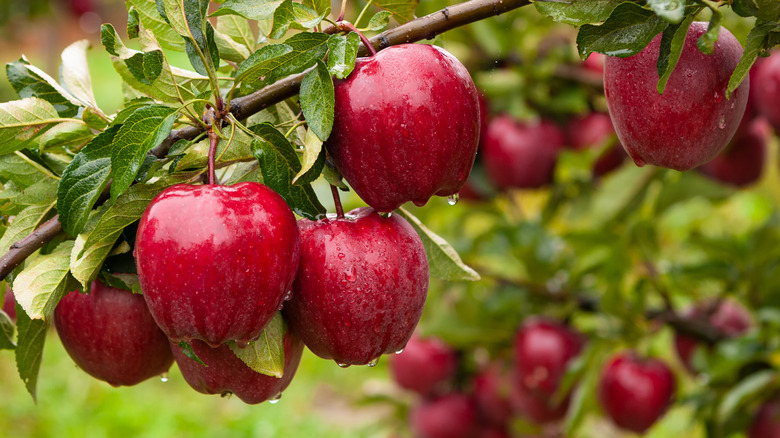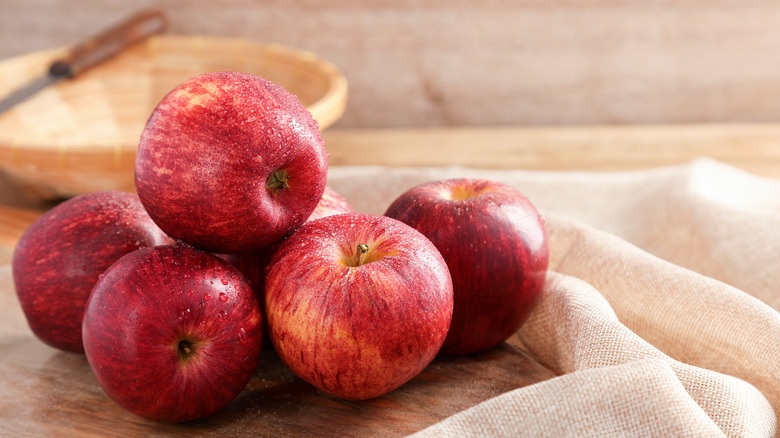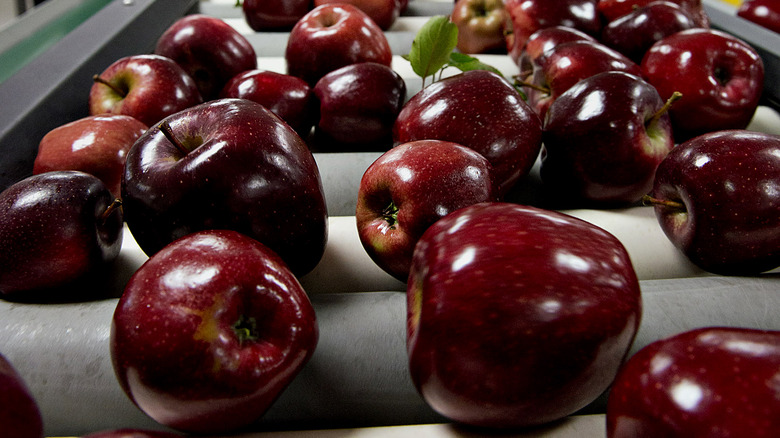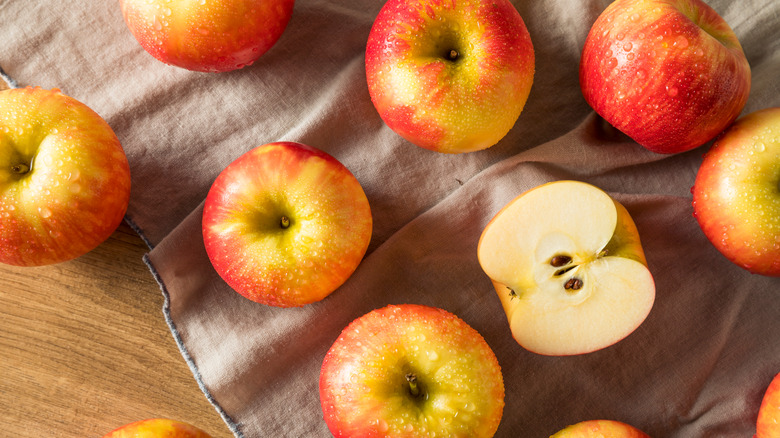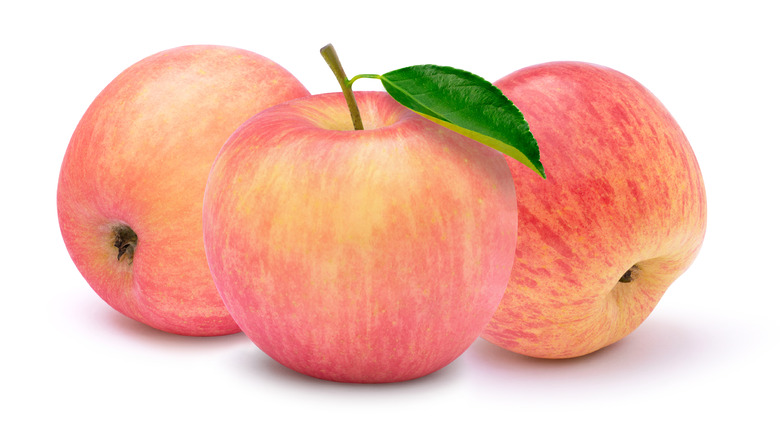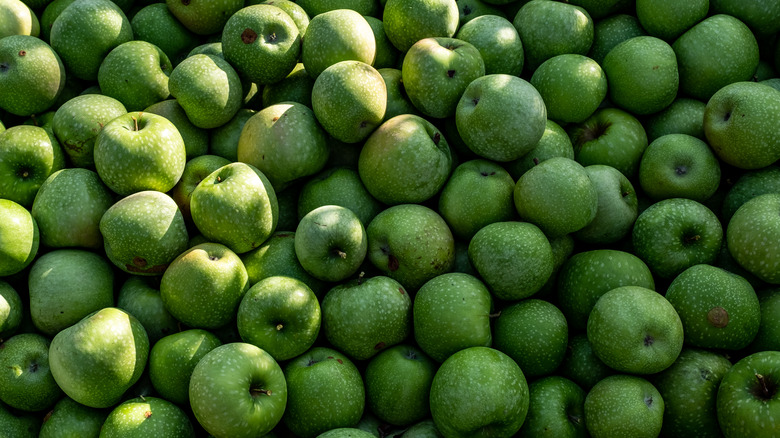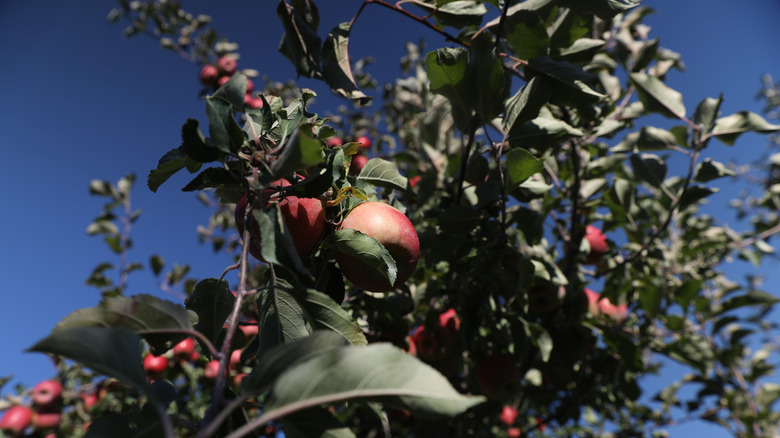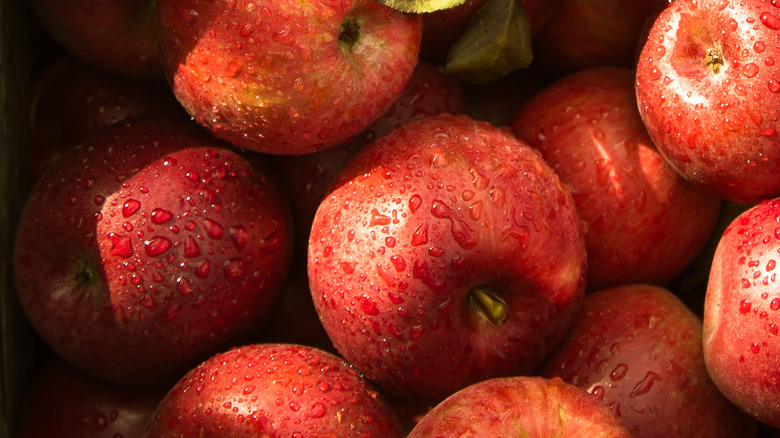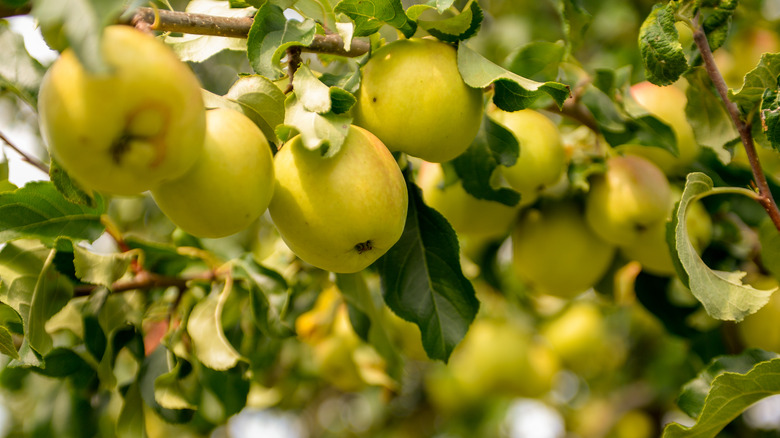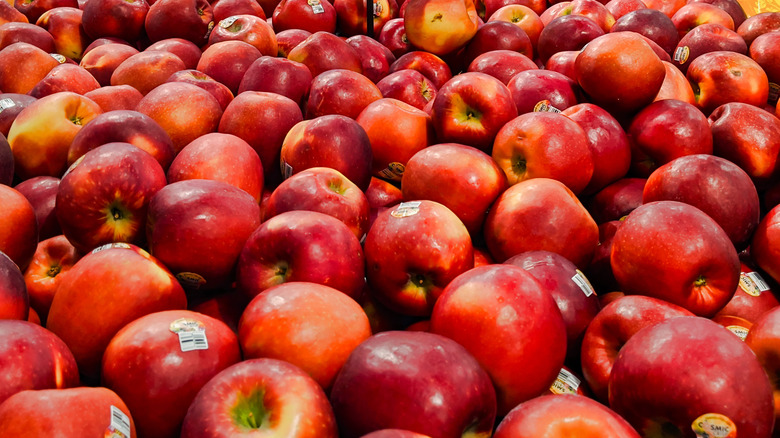The Most Popular Types Of Apples, Explained
Picking out a good apple can be a surprisingly difficult task. What's the difference between a Fuji and a Gala? If there are new types of apples, how do you know if they're any good? Is your favorite apple for snacking also going to taste good baked? And don't even get us started on the perils of going apple picking and entering into a whole new world of apple names and questions.
In an effort to take a bite out of these queries, we've put together a guide to the most popular types of apples: from what they are to where they came from and what they're best for. (We've even thrown in a few apple-based facts just for fun.)
Even if you think you have your favorite type of apple all figured out, the market is constantly changing as new varieties are created and introduced. Here's our guide to the best and most popular types of apples, explained.
Gala Apples
A variety the New York Apple Association says was originally created in New Zealand, Gala apples are mild in flavor, with a pleasant crispness and a bit of sweetness. They're also very popular, sitting in the number one spot in terms of overall U.S. apple sales. The American apple industry's professional organization US Apple estimates that over 49.3 million bushels were produced in 2021, amounting to about 19% of the overall apple market.
US Apple spokesman Director of Industry Affairs Mark Seetin says the apple's wide appeal could also be because of how easy it is for producers to grow. "It requires less fussiness to produce," says Seetin, noting "It has good storability and good flavor." The New York Apple Association explains Gala apples are great in salads and in kids lunches, while the Washington Apple Commission says they're perfect in just about everything, from beverages to pies.
Red Delicious Apples
Perhaps the most ubiquitous apple to anyone who grew up in the 20th century, the Red Delicious apple is still a top-seller for a reason: As Seetin told us, "If you picked a [Red Delicious apple] off the tree when it was ripe, you'd say 'wow, this is just about the best apple I've ever tasted.'" Farmers loved them, Seetin says, because the apple — which was first discovered in Iowa in about 1860 — "was one of the easiest apples to grow," meaning trees had "superior productivity."
Unfortunately, it's Red Delicious' freshness that's in part leading to its decline. If you've bought one from a store or picked one up in a hotel lobby, you know that, while a good Red Delicious can be great, a bad one can be bland, squishy, and actually kind of gross. Seetin says that's because of Red Delicious' "storability," and its tendency to get "mealy faster than other apples." It makes sense: If you're picking up an apple at the grocery store, you're going to want one you know has staying power in your crisper — and stores are going to want to buy apples they know they won't have to throw away.
The Washington Apple Commission says Red Delicious apples are great in salads or for snacking, while the New York Apple Association offers this helpful reminder: "Red Delicious apples look great for a long time, so they are an ideal choice for holiday centerpieces and wreaths."
Honeycrisp Apples
A relative newcomer to the apple world, the Honeycrisp variety was only really introduced into stores in the '90s after it was developed at the University of Minnesota – Minneapolis-St. Paul. The Washington Apple Commission says it's "crisp and distinctly sweet," opining "This popular, versatile apple can truly do no wrong."
Setting agrees, saying "once people tasted them, the growers just wanted them, and they quickly moved up the apple chart," noting that Honeycrisp apples really started surging in sales in 2018 or 2019. According to Seetin's group, US Apple, Honeycrisps are great for "snacking, salads and sauce-making," noting that they also store well. The New York Apple Association says the fruit's sweet taste makes them popular with "children and teens," saying having a few Honeycrisps around is "a great way to encourage healthy snacking."
Fuji Apples
"An incredibly good keeper," per the Michigan Apple Commission, Fuji apples not only store well, but offer a sweet, tart flavor with only a hint of acid. The New York Apple Association says Fiji apples "have it all," and notes that apples, which originated in Japan, have "American parents" in the Red Delicious and Ralls Janet varieties, with the latter being "an antique apple that goes back to the days of Thomas Jefferson and 1793." Now you can eat like the founding fathers!
Seetin agrees, saying "because of its sweet taste, it's a great eating apple." Though you can certainly enjoy a Fuji straight up, no frills, the New York Apple Association also reccomends turning it into delicious applesauce without adding any additional sugar, which is an especially good tip if you've got little kids around. (Fun fact: Seetin says most commercially made applesauce comes from a blend of a lot of different apples, saying the Golden Delicious and York varieties are most commonly used.)
Granny Smith Apples
This list's first big, green apple, Granny Smiths are so beautiful that it's easy to see why one inspired the name and logo of The Beatles' record label and company. Granny Smiths are on the more tart end of the apple spectrum, which is probably why they're so frequently used by bakers and chefs. That way, they can achieve the effect of the taste and texture of an apple, but have more control over their dish's sweetness.
Named after a real person, Maria Ann Smith, who cultivated the apples on a farm in Australia, according to the Washington Apple Commission, Granny Smith apples are "believed to have descended from French crabapples." They're in season year round, which is great for grocery store availability.
Fun fact: When the US Postal Service issued apple-themed stamps in 2013, the Granny Smith was one of the four apples featured. The other three varieties pictured were Northern Spy, Golden Delicious, and Baldwin.
McIntosh Apples
Sweet, tart, and juicy, McIntosh apples have a lightly mottled green and red peel with white fruit inside. Unfortunately, the McIntosh is also increasingly hard to find. Seetin says that there will "always be a niche" for the traditionally Northeastern apple, which is great for baking. "People just like it," he says, "There's a lot of traditional demand for people who say, 'my grandma and my great grandma always used McIntosh apples.'" Seetin thinks McIntosh apples unfortunately tend to get mushy quickly, saying "it keeps even less well than the Red Delicious."
The New York Apple Association surely recommends you give the variety a try anyway, because McIntosh apples grow particularly well in New York. "Nothing evokes fall better than the aromatic fragrance of McIntosh apples," the organization says, noting the apple has been around for quite some time, "enjoyed since 1811 when John McIntosh discovered the first seedling."
Pink Lady Apples
This fancy-sounding apple actually isn't technically called Pink Lady — that's a trademarked name — but its scientific variety name, Cripps Pink, isn't quite so cute.
Cripps Pink apples, US Apple says, were developed in Western Australia and are a cross between a Golden Delicious and a Lady Williams apple. It's not ready to harvest until November, but US Apple says that's fine, because "Brisk, autumn nights help bring out its bright, namesake coloring." Seetin says the "long season" makes Pink Lady apples "a little trickier to grow," which could account for its relatively limited availability.
The Washington Apple Commission calls Pink Ladies "zippy," calling it a "sweet-tart of an apple" and suggesting that the fruit tastes as "bubbly as you'd expect" given it's rosy hue.
Empire Apples
Another very old apple variety, Empire apples originally hail from — surprise, surprise — New York. The New York Apple Association explains the variety was developed at Cornell University in the 1940s, with the apple's creators grafting together Red Delicious and McIntosh tree branches to create this brightly colored variety. That must have seemed like a very smart move at the time, given those two varieties' popularity, but may speak to why it's not the most popular apple today.
Empires are sweet, tart, and juicy, but they also tend to be on the smaller side. That's great for parents who might want to send an apple in their kids' lunch, but that's not necessarily a booming market. Seetin says Empires have "reached their peak and are going down," continuing, "It was really a great apple in its time, but the apple breeders have improved upon it."
Golden Delicious Apples
The lone yellow apple on this list, Golden Delicious apples are smooth, sweet, and often used to make cider and applesauce. The Washington Apple Commission says Golden Delicious apples have an almost "mellow gingerbread spice" flavor to them, which is probably why they pair so well with flavors like cinnamon and nutmeg.
Despite their delicious smoothness, Golden Delicious apples are declining in popularity — at least in terms of how many are being grown in the U.S. today. Seetin says that's actually pretty sad, noting that "My wife and I participated in a food tasting exercise at the elementary school where she taught, and I got a box of delicious apples from a particular [Northeast] nursery. They beat out Honeycrisp in that taste test, because of the way they had been grown and the way they had been stored. They had a superior taste." Basically, if you're at a farmers market in the Northeast in the fall and you see fresh Golden Delicious apples, pick one up because you could be surprised by how delicious they are.
Cosmic Crisp Apples
By far the newest apple variety to make our list, Cosmic Crisp apples have really burst onto the grocery store scene with a ferocity in the past couple of years. Invented and grown mostly by Washington farmers, the Cosmic Crisp apple certainly receives a rave review from the Pacific Northwest state's Apple Commission. "Imagine a large, juicy red apple that's explosively crunchy and bursting with plenty of sweetness," the site says. "Add a bit of tang. Now imagine it's real. A dream apple so good it's out of this world."
Though that praise is certainly a tad effusive, Seetin agrees that the Cosmic Crisp is a particularly good variety, calling it "aptly named" and "a really excellent apple." He says the variety's popularity is due in part to Washington farmers coming together to commit to growing the apples. "The Washington State apple growers basically said, 'Wow, this is a terrific Apple. We think it's got traits that are superior to other competing apples — among them Honeycrisp — and it stores better and isn't as sensitive," Seetin says, explaining that Honeycrisp apples are "very sensitive to the slightest bit of damage."
Seetin further explains that the best way to get a new apple variety to market is for growers to "collectively produce and promote it," something that Washington growers are definitely doing. Cosmic Crisp is actually the variety's trademarked name (there's even an official website). Seetin says Cosmic Crisp is what's known as a "managed variety," explaining "an owners group bought the rights to the particular variety of apple, and to grow it you have to pay a royalty." Seetin shared, "the reason they want that is to maintain uniform quality of that fruit."
